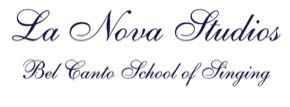From Farinelli to Frank Sinatra, the influence of Bel Canto is widespread and long-lived. It is a singing style which has relevance and merit for all singers – not just classical.
In this clear, and concise book, Michelle Nova and Patricia Collins examine the origins and history of Bel Canto – taking into account the subtle changes in terminology and phrasing over the generations – and explain vocal anatomy and show how to apply Bel Canto technique. Thereafter, they give practical information on word sounds, how to sing a song, methods of preparation, and learning techniques. Also included are valuable appendices covering vocal exercises and examples of singers who themselves use Bel Canto technique.
To order 'Singing Bel Canto' please click here:
(for non-UK purchases please contact Michelle direct here)
SINGING BEL CANTO - ART & SCIENCE
Michelle Nova & Patricia Collins
Reviewed by Maria Rivington
The survival of the Bel Canto technique of singing and its methods – although documented over the past 300 years from Tosi (1713) to the present day
– still rely on a close teacher/pupil relationship. And although we know a great deal more about vocal anatomy today, visualisations and analogies still step in to illustrate the physical processes we cannot capture visually.
This “mystery” around singing teaching generally and Bel Canto in particular, sparks continual debate. However, most contemporary schools of vocal teaching will share common grounds with some Bel Canto principles.
Aiming for clarity, singing teacher Michelle Nova and Professor of Anatomy, Patricia Collins, fuse chapters of detailed explanations of the vocal anatomy - interspersed with practical, observational exercises and plenty of illustrations - with chapters outlining the key elements of Bel Canto principles; the “Imposto” (placing in the sinuses) the “Appogio” (breath/resonance in the head), the open, Italian vowels etc.
The structure of the anatomical chapters following the airflow through the body from inhalation to singing is well conceived. Practical exercises are detailed and further along, sections on pronunciation using songs as examples and a Glossary, are excellent.
As a semi-independent teaching tool, this is a very useful volume. However, younger learners (and some adults, too) may grapple with the dense anatomical language and would achieve even further clarity from e.g. internet links to filmed examples of exercises. I am looking forward to it!

